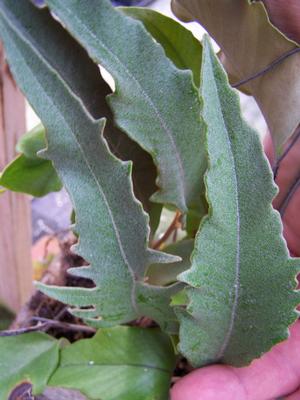View All Plants :: View All FERNS :: View All SHADE PERENNIALS :: View All TENDER PERENNIALS
Pyrrosia lingua 'Kei Kan'
Japanese Tongue Fern
Plant Type:
FERNSPyrrosia lingua 'Kei Kan' - 'Kei Kan' translates to strong and fierce. Large serrations create the effect of irregularly-toothed blades, deep green and leathery. Some of these serrations which are large enough to be virtual lobes are themselves serrated - the gestalt of leaves really striking, architectural and beautiful. Leaves can achieve 4 inches wide on happy, well-grown specimens on 'Kei Kan', one of the many worthy selections of Tongue Fern. Keep moist and shaded. A good collector plant for a greenhouse setting or a botanic garden for that matter it will also make a fantastical specimen in a southern shade garden. We keep all our Pyrrosia lingua cultivars in our cool greenhouse in an openly shaded siting where it carves out a strong and fierce presence; it will certainly do so in the USDA zone 7 garden and south. The specie's nativity is China and Japan. Pot grown division.
Height:
6-8 inCharacteristics and Attributes for Pyrrosia lingua 'Kei Kan'
Season of Interest (Foliage)
- Four Seasons
Nature Attraction
- Deer Resistant
Light
- Dappled Shade
- Morning Sun / Afternoon Shade
- Shade
Attributes
- Conservatory
- Natural Garden
- Border
- Potted Plant
- Collector Plant
- Bank
- Edging
- Woodland
- Epiphyte
- Evergreen
- Greenhouse / Alpine House
- Ground Cover
- Hanging Basket
Growth Rate in the Garden
- Medium
Origins
- China
- Japan
Propagated By
- Division
Genus Overview: Ferns
Ferns. The easy, elegant and exceptional beauty of ferns cannot be understated. All ferns, beautiful as specimens unto themselves, are extraordinary in their simple ability to provide rich contrast to other companions wherever their requirements befit.
Habituated to so many environments many of the ferny pteridophytes – vascular plants that reproduce by spores, not seeds - are woodland denizens thriving on the cool, damp forest floor like the Christmas Fern, Polystichum acrostochoides with some preferring the wetter disposition of bogs, swamps, and stream banks such as Osmunda cinnamomea. Others will colonize gritty soils in shade or sun like the running Hay-scented fern, Dennstaedtia punctilobula and many among the Cheilanthes. Some are tough enough to grasp a foothold in the crack of a rock, these are lithophytic, as with Asplenium trichomanes. And some – most of these tropical in origin are truly epiphytic, clinging to tree bark as they unfurl their fronds from embryonic croziers to reach into the forest light such as the primitive looking Staghorn Fern, Platycerium bifurcatum or Rabbit-foot Fern, Davallia fejeensis .
And many have historic medicinal uses such as Maidenhair Fern, Adiantum pedtaum – this from medicinalherbinfor.org, “Expectorant, anti-rheumatic, demulcent, pectoral, refrigerant, tonic”... Native Americans throughout North America used maidenhair as a hair wash to make their hair shiny.” And in a more Bacchanalian use: as a flavoring in liquers.
There was probably something fern-like, an ancient ferny forebear(s) if you will, living during the Devonian some 60 to 70 million years ago. Ferns, some we still recognize today are descendents from an ancient order whose reign during the Carboniferous Age is legend, where giant horsetails and monstrous club mosses still populate the misty recesses of our dreams... and whose contemporary plundering by Homo sapiens in the vast burning of fossil fuels is altering our climate at such an alarming rate that more among the many are beginning to query as to the potential for another mass extinction – the closing chapter of another age, a blip in the larger context of perceived time. But I digress....
All our offerings are well-rooted pot grown divisions in 5 pint squares unless otherwise indicated. The quality we offer make them worth the money. We think you will agree.


